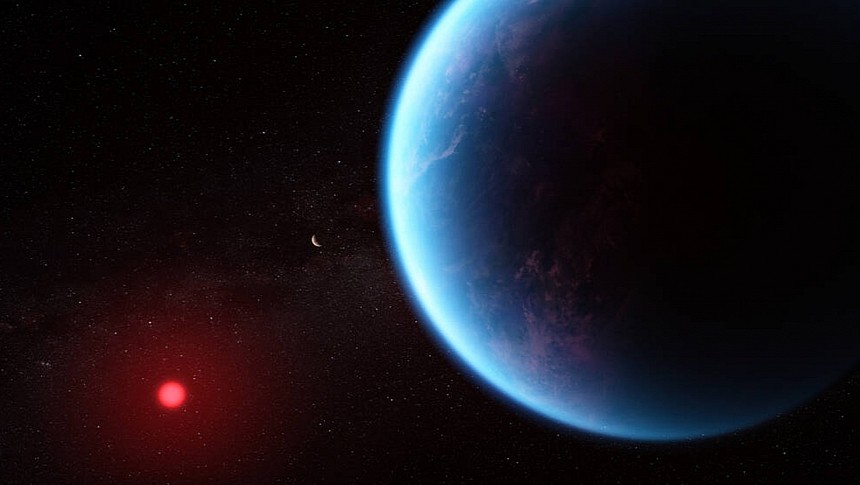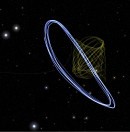By most ostensible measures, the observable universe is so enormous, so widespread, and so indescribably vast that the chances of finding life somewhere in the cosmos seem more like a mathematical certainty than conjecture. Still, this doesn't make finding concrete proof of alien life any less difficult. Even so, the James Webb Space Telescope may have revealed some of the most solid evidence we've seen in ages. It's all thanks to a little-known exoplanet roughly 120 light-years away from Earth called K2-18 b.
By non-astrophysicist standards, K2-18 b is a peculiar exoplanet. One roughly 8.6 times the size of Earth by the latest measurements. It orbits its home star, K2-18, in the Leo constellation, at a range generally accepted to be within the habitable zone where microbial life can theoretically develop and evolve. At least, life by Earth's standards should have a good chance of developing. But until the James Webb Space Telescope put its focus on K2-18 b, there was no concrete proof to this effect. However, recent studies of JWST's findings about K2-18 b appear to indicate the presence of carbon-based molecules inside the exoplanet's atmosphere, which, on Earth, often comes from the presence of life.
Molecules taken for granted here on Earth, like carbon dioxide and methane, have been identified on K2-18 b by JWST using its powerful infrared detection suite. But of all the chemical compounds identified on the planet, all pale in significance to the possible presence of dimethyl sulfide, or DMS for short. Here on Earth, DMS is a metabolite compound for certain groups of marine algae, and its cabbage-like smell is associated with the cooking of various fruits and vegetables like corn, asparagus, beets, truffles, and even some tomato products. With this in mind, when DMS is found anywhere on Earth, it's nearly always associated with the presence of life. More often than not, with the presence of plant life, but also in various forms of seafood.
With this potential groundbreaker discovery on the cusp of being proven true, it's not hard to imagine K2-18 b as a lush ocean planet with an atmosphere laden with hydrogen, warm and salty oceans, and an abundance of hydrocarbon compounds either at sea, on land, or in the air. Known as Hycean planet (a portmanteau of hydrogen and ocean), scientists believe these kinds of worlds yield the highest possibility of showing evidence for signs of life, either in the past or in the present, somewhere on its surface, in its oceans, or in its atmosphere.
In the relentless quest to find life on other heavenly bodies, JWST's latest findings might be some of the most promising in the 21st century. When you remember this prized infrared space telescope's only been operating since 2022, and the scale of what it might one day discover becomes truly breathtaking.
Molecules taken for granted here on Earth, like carbon dioxide and methane, have been identified on K2-18 b by JWST using its powerful infrared detection suite. But of all the chemical compounds identified on the planet, all pale in significance to the possible presence of dimethyl sulfide, or DMS for short. Here on Earth, DMS is a metabolite compound for certain groups of marine algae, and its cabbage-like smell is associated with the cooking of various fruits and vegetables like corn, asparagus, beets, truffles, and even some tomato products. With this in mind, when DMS is found anywhere on Earth, it's nearly always associated with the presence of life. More often than not, with the presence of plant life, but also in various forms of seafood.
With this potential groundbreaker discovery on the cusp of being proven true, it's not hard to imagine K2-18 b as a lush ocean planet with an atmosphere laden with hydrogen, warm and salty oceans, and an abundance of hydrocarbon compounds either at sea, on land, or in the air. Known as Hycean planet (a portmanteau of hydrogen and ocean), scientists believe these kinds of worlds yield the highest possibility of showing evidence for signs of life, either in the past or in the present, somewhere on its surface, in its oceans, or in its atmosphere.
In the relentless quest to find life on other heavenly bodies, JWST's latest findings might be some of the most promising in the 21st century. When you remember this prized infrared space telescope's only been operating since 2022, and the scale of what it might one day discover becomes truly breathtaking.








